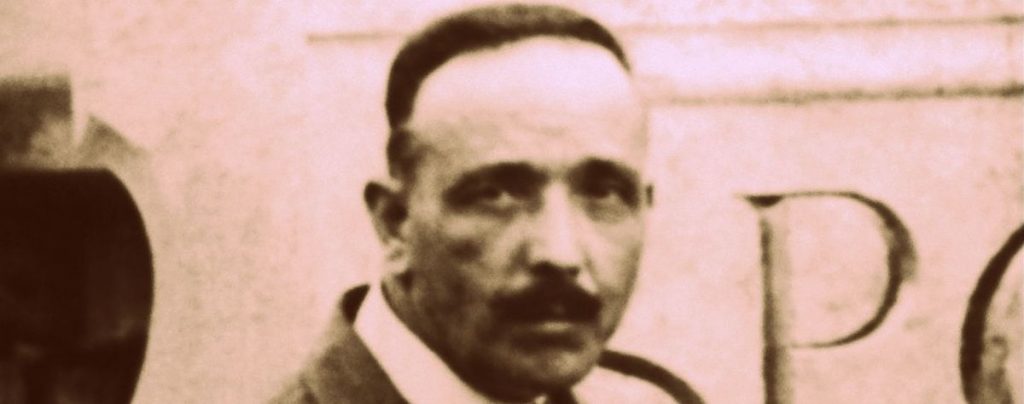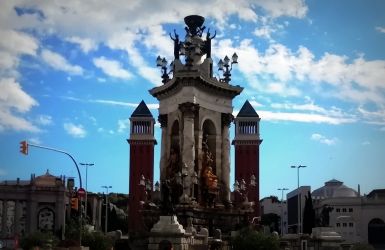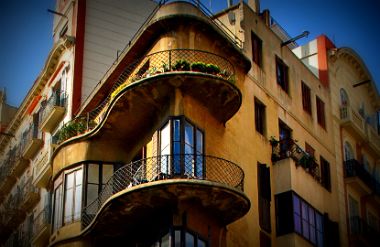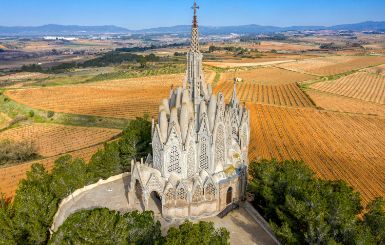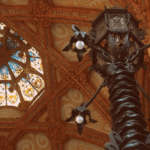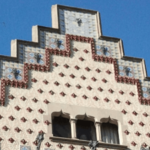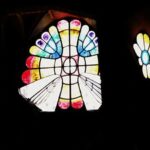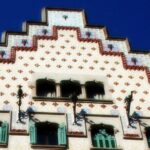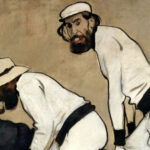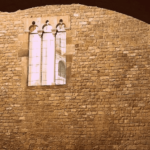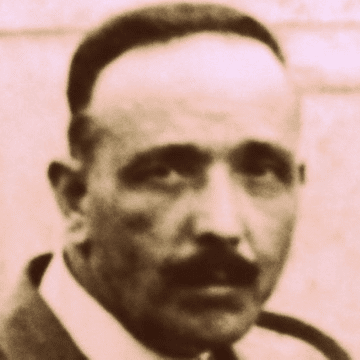
Who was Josep Maria Jujol?
JUJOL, GAUDI'S RIGHT HAND
My second grade in primary school was Miss Jujol. I don’t have many memories of her classes, but I do remember hearing that her father had worked with Antoni Gaudi. Of course, as a 7-yo that didn’t mean much to me. Then she gave us some subjects in fourth grade again.
So I got to hear the story a few times more and that left an imprint on me: the knowledge that my teacher’s dad had been someone important. And as an adult, architecture love and tour guide, the architect Jujol has become a key character despite his modest personality.
Top works of Josep Maria Jujol, architect:
1
Casa Batllo, la Pedrera and Park Guell, collaborating with Antoni Gaudi (1905-1914)
Both Gaudi and Jujol were born and raised in the Camp de Tarragona area (Gaudi in Reus and Riudoms, Jujol in Tarragona). Both shared a love for nature that inspired their creations. Both paid attention to detail and loved combining a variety of materials.
Specialists agree that Josep Maria Jujol added color and playfulness to Gaudi’s works. Some even state that in some cases it’s difficult to say where Gaudi ends and Jujol starts. The truth is that Jujol started collaborating with Gaudi for the master’s first masterpiece, Casa Batllo, and they continued to work together from then on. They were also loyal friends to each other.
Not even graduated from Architecture School yet, Jujol was in charge of the colorful elements of the façade of Casa Batllo. Later on in La Pedrera (Casa Mila) he worked on the wrought iron balconies as well as the intricate decoration of the apartments. But his most famous work in a Gaudi project was Park Guell , where he supervised the trencadis ceramic mosaic of the undulating bench as well as the medallions of the ceiling in the columns room.
Actually, while some say Gaudi started using broken tiles when after a strike he could only get leftover tiles from the factories, other prefer to say that Jujol had the idea to use broken tiles when a ceramic dish broke at home during a meal.
2
Monumental Fountain in Plaça Espanya, Barcelona (1929)
Plaça Espanya is one of the main accesses to the Hill of Montjuic. If you go to see the Magic Fountain Show, you’ll be arriving through it. When you do, have a look at the monumental fountain in the center of the turnabout. It’s one of the late works of Josep Maria Jujol.
In 1929 took place the second World Fair of Barcelona. Jujol was commissioned the Education Pavilion. Having been a university professor, he was pleased with the project. However, in the end the Pavilion theme changed to Fashion – and he wasn’t too happy about it. Unfortunately, the building doesn’t exist anymore as it was damaged during the bombings of the Spanish Civil War (1936-39).
He was also the author of the fountain that decorated the main access to the fair. Its very classic style had to match the neoclassic columns of the pavilions that faced it. And that means it has little to do with Jujol’s true style. It has a strong Italian feel, and it represents the three seas surrounding Spain: the Mediterranean Sea, the Atlantic Ocean and the Bay of Biscay.
Built against the clock, it seems it couldn’t be completed on time for the opening ceremony of the World Fair. It is said that the builders and the working class of the neighborhood used the scaffolding to watch it from the distance.
3
Casa Planells, Barcelona (1922-24)
Also like Gaudi, Jujol was unable to complete several of his works. That’s the case of this apartment building on 332, Diagonal av. In the beginning, it was to be a single-family dwelling. However, economical problems forced Mr. Planells to sell part of the plot. Jujol then had to rethink the project and turn it into a residential building.
The street level was destined to commercial facilities, as it was common in the Eixample. The mezzanine could be rented as an apartment, but eventually Mr. Planells used it for his own office. His family occupied the entire main floor. And the rest was divided in three apartments to rent, much larger than one would think looking at the building from the street.
What could have been a modern “La Pedrera” became a modest corner building that hardly catches the attention of the people passing by. However, its wavy balconies are a testimonial of the architect’s creativity to scrape a few extra square feet for the interiors. Unfortunately, in the end Jujol didn’t even get to finish the building. Mr. Planells money problems forced him to sell the building half way through its construction and the new owners had it completed by someone else.
There’s more works of Jujol in Barcelona: as a young man he collaborated in an altarpiece of Santa Maria del Mar and the restoration of the rose window of Santa Maria del Pi. He designed the elevator and the library mezzanine of the Ateneu Barcelonès on Canuda st, as well as the elevator of the apartment building on 284, Mallorca st.
And in the Creueta del Coll area he created the staircase and the house of the concierge of Finca Sansalvador. He was meant to build a summer residence for the owners there, too, but the project was stopped when a water spring was found in the area and the family Sansalvador decided to commercialize its water.
4
Can Negre, Sant Joan Despí (1915-1926)
Sant Joan Despi is a quaint town right outside of Barcelona, now famous to house the main headquarters of TV3, the Catalan TV. But it’s also the town with most Jujol works within its territory. And it all started when in 1913 Jujol’s aunt Josefa Romeu asked him to build her a summer residence, Torre de la Creu.
The lawyer Pere Negre saw it and was fascinated by Jujol’s creativity, and commissioned him the renovation of his family farmhouse, Can Negre, so it could also be their Summer residence. The result was even more stunning. Starting from the “carriage”, the impressive balcony that resembles a horse drawn coach, to the family chapel and the main staircase, everything there makes your mind blow.
Can Negre is nowadays a public center dedicated to Josep Maria Jujol and they regularly organize guided tours to discover his local works. That includes the house he built so he could stay overnight in the village to supervise his projects, as well as private properties such as Torre Serra-Xaus, Casa Rovira, the church of Sant John the Baptist or the wrought iron door of the workshop of his blacksmith, Josep Oliver.
5
Metropol Theater, Tarragona (1908-1910)
The Patronat Obrer of Tarragona wasn’t a working class union as its name might make us believe. It was instead a board of the local bourgeoisie created to get the favors of the Tarragona bishopric through charity and (catholic) educational programs. But still, a rich people’s club.
They owned a building in the main street, the Rambla Nova, where they organized free primary school, catechism and drawing lessons. But its location was too tempting. The idea of turning the facility to a leisure center for the well-off started taking shape. In 1907 the Patronat Obrer invites Gaudí, Jujol and their team to visit the building, and the next year Jujol takes up the project of transforming it into a theater venue.
Tarragona is known for its Roman heritage, but it’s also an active fishing port. That’s why it’s not strange that Jujol was inspired in the image of a ship against the waves. But it’s also full of religious symbolism, the “ship” representing the Catholic Church saving its people from the ups and downs of life. Yes, Jujol was as a fervent Catholic as Gaudi was. So the entire Metropol theater structure reminds us of a vessel, and its decoration includes many references to the sea and the fishing world, as well as to Catholicism.
Unfortunately, the building was severely damaged during the bombings of the Spanish Civil war. It wasn’t until 1991 that the Tarragona city council purchased it with the idea of restoring it. It was inaugurated in 1995, and since then it offers a regular program including theater plays as well as music and dance shows.
AND FINALLY! What's Jujol's building that most resembles to Gaudi's style?
6
Montserrat Sanctuary, Montferri (1925-1930, 1987-1999)
30 minutes outside of Tarragona, or some 80 minutes drive South of Barcelona, there’s the little village of Montferri. On top of a small hill right outside of it, surrounded by vineyards and carob trees, there’s a surprising white building. You’d say it’s a mini-Sagrada Familia.
In the early 1900’s, the people in Montferri were very devoted of our Lady of Montserrat. Every year after the grapes harvest, they’ll organize a pilgrimage to the Monastery of Montserrat. What now is 1.5 hours drive, it was almost a day on foot. So in order to spare them the long trip, the Jesuit monk Daniel Vives and his brother Josep decided to build a sanctuary in a land of their property. And Jujol was… their cousin. Of course, they asked him to build it.
The construction started in 1925. The villagers contributed to the project, either with donations or their own labor. But the money wasn’t enough, and the pre-war political climate led to stopping the works. Only a third part of the project had been built.
But in the 1980’s the neighbors were decided to have it finished. They raised money selling lottery and agreed to help in the construction carrying materials with their own tractors. So in 1987 the works started again. Jujol having passed away almost 40 years earlier, Joan Bassegoda i Nonell, architect and renowned specialist in Gaudi, was in charge of completing it.
The chapel has been open to the public since 1999, every Saturday and Sunday morning. The rest of the week its opening hours may vary, so it’s better to check with them before planning a visit. Everything in the building reminds us of Gaudi: from the parabolic arches and its geometry, to the nature inspiration, from the use of simple materials and the sunlight through the stained-glasses. It makes you think how much the minds of these two masters had in common.
By the way, did you know John Malkhovich is a fan of Josep Maria Jujol?
Marta
MORE BARCELONA TIPS FOR YOU:
SHARE WITH YOUR TRAVEL MATES
RESEARCHING FOR A TRIP IS TIME-CONSUMING…
Need more inspiration?
Our 100% FREE Barcelona Collection will give you everything you need to organize the trip of your lifetime to Barcelona.
BEST INSIDER TIPS FROM THE PROS!

Last update on 2024-04-25 / Affiliate links / Images from Amazon Product Advertising API

